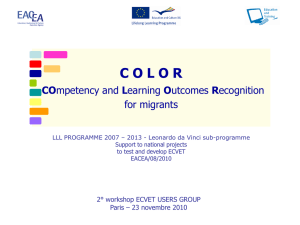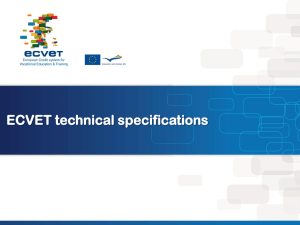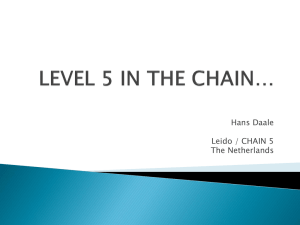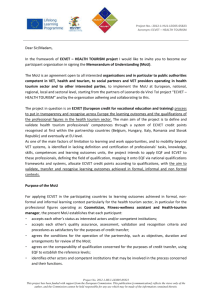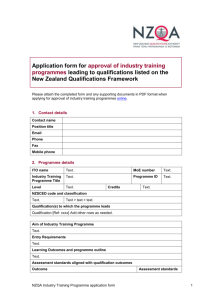Methodology Guidelines
advertisement
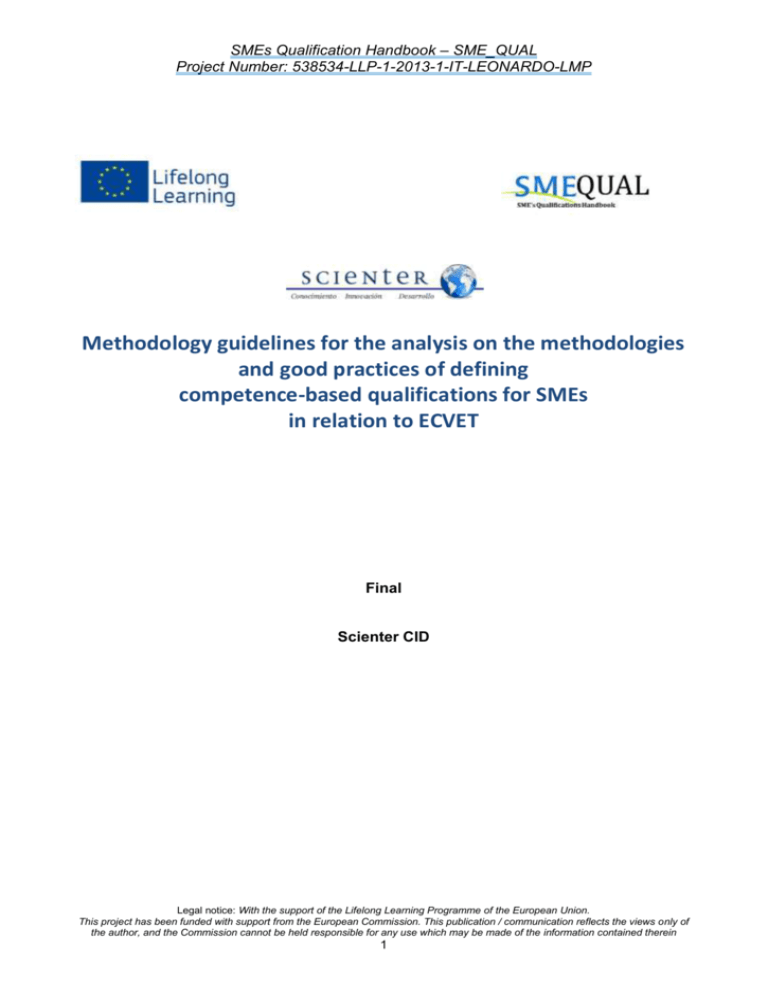
SMEs Qualification Handbook – SME_QUAL Project Number: 538534-LLP-1-2013-1-IT-LEONARDO-LMP Methodology guidelines for the analysis on the methodologies and good practices of defining competence-based qualifications for SMEs in relation to ECVET Final Scienter CID Legal notice: With the support of the Lifelong Learning Programme of the European Union. This project has been funded with support from the European Commission. This publication / communication reflects the views only of the author, and the Commission cannot be held responsible for any use which may be made of the information contained therein 1 SMEs Qualification Handbook – SME_QUAL Project Number: 538534-LLP-1-2013-1-IT-LEONARDO-LMP 1. General Background European and training policies The Bruges Communiqué on enhanced European Cooperation in Vocational Education and Training for 2011-2020 states as strategic objectives: 1. Enabling flexible access to training and qualifications through the definition of qualifications in terms of learning outcomes and with the attribution of ECVET points. 2. Developing a strategic approach to the internationalization of I-VET and C-VET and promoting international mobility, considering that economic globalization encourages employers, employees and independent entrepreneurs to extend their scope beyond the borders of their own countries. The Education and Training 2020 Framework (ET 2020) explicitly sets a benchmark 15% of adults participating in learning programmes. For reaching this objective it is necessary to apply common European instruments and principles and use them to promote mobility for VET learners and to encourage more adults to take up continuing training. For reaching the above mentioned political priorities, several lifelong learning instruments have been recommended at European level to the member states: ECVET, EQF, EQAVET, Europass, ECTS. ECVET and other European instruments 1. Definition of ECVET The European Credit system for Vocational Education Training (ECVET) aims to facilitate the accumulation, transfer and recognition of knowledge, skills and competences gained by individuals who are aiming to achieve a Qualification.1 It was developed by Member States together with the European Commission’s Directorate General Education and Training. Recently, the ECVET regulatory framework was adopted by the European Parliament and the Council on 18 June 2009 through Recommendation 2009/C 155/02. 2 ECVET implementation ECVET implementation is possible if each unit is documented and the learning outcomes it contains are assessed, and validated. Hence learners can: Progressively (unit-by-unit or set of units by set of units) accumulate learning outcomes in view of achieving a qualification; Obtain recognition for their learning outcomes achieved in other contexts without new assessment (i.e. units can be transferred because the learner can provide the receiving institution 1 Source: European Commission, DG EAC, The European Credit System for Vocational Education and Training ECVET – Get to know ECVET better. Questions and Answers, Revised by February 2011. Legal notice: With the support of the Lifelong Learning Programme of the European Union. This project has been funded with support from the European Commission. This publication / communication reflects the views only of the author, and the Commission cannot be held responsible for any use which may be made of the information contained therein 2 SMEs Qualification Handbook – SME_QUAL Project Number: 538534-LLP-1-2013-1-IT-LEONARDO-LMP with evidence that s/he has been successfully assessed and has achieved the concerned learning outcomes). In countries where qualifications are not designed in terms of units or where they do not allow for the accumulation of units, it is possible to use ECVET for mobility purposes by creating units used only for mobility. 2 Units should be constructed and organised in a coherent way with regard to the overall qualification. To group the learning outcomes into units it is necessary to identify those outcomes that relate to each other. There are different criteria according to which learning outcomes can be grouped into units and the choice of which criteria to use depends on the qualifications system. Examples include: The fact that the learning outcomes relate to the same set of occupational activities/tasks (for example the learning outcomes in a unit entitled “shampooing and hair treatment”); The fact that they are related to the same product or production technique (such as the learning outcomes in a unit entitled “prepare grilled dishes”); They can also be grouped according to the stages in the production process or process of performing a service (for example the learning outcomes in a unit called “informing the client about the nature of maintenance intervention”); or They can be grouped in a unit because they relate to the same field of knowledge, skills or competence (for example the competence in foreign language can form a separate unit). 3 3 ECVET Benefits for Individuals, employers and training providers the Learning Outcomes approach can be seen as an opportunity to tailor education and training to individual needs, improve links to the labour market and improve the way non-formally and informally acquired Learning Outcomes are recognized. (…) i.e., ECVET can help in including mobility experience as part of a qualification and allows a flexible mapped development of qualifications which improves the employability of SMEs employees and young people entering to the world of work.4 By providing more homogeneity to training programmes offered by external training providers, it raises the attractiveness and transparency of the training programmes to individuals and SMEs and increases cooperation between VET providers.5 SMEQUAL contribution to these aims and approach External conditions, infrastructures and educational & training system, which now are binding on SMEs, have slowed down productivity. Today, the basic needs of SMEs are represented by the reaffirmation of the quality of the products, the recognition of the human factor, the consolidation 2 Idem Ibidem 4 EACEA and EBTN, BIF project’s ECVET User Guide, Leonardo da Vinci programme, oct.2011 5 Idem 3 Legal notice: With the support of the Lifelong Learning Programme of the European Union. This project has been funded with support from the European Commission. This publication / communication reflects the views only of the author, and the Commission cannot be held responsible for any use which may be made of the information contained therein 3 SMEs Qualification Handbook – SME_QUAL Project Number: 538534-LLP-1-2013-1-IT-LEONARDO-LMP of skills, through continuing training resources and effective recovery of the technological inferiority of the other European countries. Thus, the main problems to be addressed refer to the awareness and implementation of the lifelong learning instruments, in particular to the ECVET application. These instruments (ECVET, EQF and EQAVET) are systemic instruments that depend very much on national political strategies and changes, but ECVET application, in particular, need to be strongly supported also by VET providers. These are the stakeholders who should put them into practice within VET programmes in order to make mobility and transparency happen, for the SME across Europe. The SME-QUAL project aims to improve the quality of training systems for SMEs, by incorporating the ECVET provisions foreseen in the Recommendation of the European Parliament and of the Council establishing the ECVET system. In particular, the project will provide operational European Guidelines and methods for the implementation of ECVET provisions in the VET programmes, for the SMEs. The project sets the following concrete objectives: 1. Analyse the existing experiences and good practices in designing qualifications for SMEs, in units of LOs and with the attribution of ECVET points, in three Partners countries (BE, IT, PL) 2. Develop the “European Handbook for the LOs based Qualifications for SMEs’, which will include operational methods and guidelines for defining learning outcomes based qualifications for the SMEs. LOs and quality assurance are not deeply known in neither by VET providers, nor SMEs employees in Europe. SMEs themselves and the social partners are often not even aware of what is available at European level for professional qualification design. Thus, the expected results of the European Handbook for learning outcomes based Qualifications for the SMEs is to bring more trust and confidence in the qualifications of the SMEs, in LLL opportunities and to enhance the mobility of employees across Europe. 3. Test the “European Handbook for the LOs based Qualifications for SMEs’ on a qualification prototype: HR Planning & Recruitment Expert. 4. Define and test the quality standards for the ECVET implementation within competencebased SMEs qualifications. Legal notice: With the support of the Lifelong Learning Programme of the European Union. This project has been funded with support from the European Commission. This publication / communication reflects the views only of the author, and the Commission cannot be held responsible for any use which may be made of the information contained therein 4 SMEs Qualification Handbook – SME_QUAL Project Number: 538534-LLP-1-2013-1-IT-LEONARDO-LMP 2. Scope of the Methodological guidelines This supporting document aims at providing the methodological framework to set out the procedures and instruments to be followed by the project partners for the identification and analysis at national and European level of existing methodologies and good practices for designing competence based qualifications for the SMEs and for the identification of the current state of art of ECVET implementation by HEI (Higher Education Institutions) and VET (Vocational Education Training) providers. Moreover, the analysis will also help the Consortium to identify the needs and gaps to be addressed, and to collect recommendations for designing qualifications in term of LOs and with the attribution of ECVET points. However, during the Kick-off meeting celebrated in Granada on 11-12/11/2013, after having a debate on the methodological approach, the project partners came to the conclusion that in order to involve training organizations in the project development phase and to guarantee the wide validation of the project outcomes, partners should already start the WP6 desk research for the definition of the qualification at this stage (see KoM Minutes and new proposed Action Plan & Gantt Chart), in order to include a synthesis of the qualification description to the survey to be discussed with the analysis target groups. Thus, the objective would be also to verify the usefulness and applicability in different learning contexts of the professional description approach proposed and to make sure that it is coherent with the ECVET recommendations. The European qualification identified after the KoM partner´s brainstorming was called: HR Professional. The analysis will be based on a common methodology, an online questionnaire and structured interviews. These tools will be implemented mainly in three project countries: BE, IT, PL. In addition, throughout the questionnaire and interviews partners will also collect existing practices and suggestions regarding the most relevant quality standards for the ECVET implementation on qualifications for the SMEs. The review and posterior analysis of results will involve the project partners listed below: P1 – University of Roma Tre (IT) P2 – Effebi (IT) P4 – EAPM (BE) P5 – Eurocadres (BE) P6 – Confapi (IT) P7 – Paiz (PL) P6 – Scienter CID, is the partner in charge of the development of WP3 methodology for the analysis, analysis of data and provision of the report and recommendations, in collaboration with Eurocadres (P5) and Confapi (P6). Legal notice: With the support of the Lifelong Learning Programme of the European Union. This project has been funded with support from the European Commission. This publication / communication reflects the views only of the author, and the Commission cannot be held responsible for any use which may be made of the information contained therein 5 SMEs Qualification Handbook – SME_QUAL Project Number: 538534-LLP-1-2013-1-IT-LEONARDO-LMP The results of the analysis of data will be reported in a European Synthesis Report that will be used for the implementation of the WP4 and WP6. On the basis of the data gathered, partners will select the most relevant good practices and recommendations to be considered for the definition of the “European Handbook for the Learning Outcomes (LO) based Qualifications for SMEs”. 5. Methodology of Data collection To define the methodology for performing the analysis on methodologies and good practices of defining competence based qualifications for SMEs, the consortium agreed on the following aspects to be considered: 1. METHODOLOGICAL STEPS ANALYSIS OF GOOD PRACTICES DEFINE A EUROPEAN QUALIFICATION LOs based qualifications designed by: HEI VET ECVET knowledge/awareness and application Recognition of LOs achieved in formal, informal and non-formal learning contexts Assessment (work based and competence based) How we identify the good practices? Descriptors for defining the Units of the Qualification 2. 1. 2. 3. 4. Useful - increase employability Recognisable in the labour market Transparent Flexible - can be achieved through different learning paths: formal, non formal and informal, including work/life prior experience 5. Supporting lifelong learning (CDP) Define A EUROPEAN QUALIFICATION IN LINE Design a qualification that integrates WITH ECVET/EQF/EQAVET REQUIREMENTS ECVET/EQF/EQAVET instruments: (HR Professional) Through ECTS integration Compatible with ECVET/EQF/EQAVET Definition of job profile & descriptors, Units, LOs and recommendations of possible learning paths/instruments Attribution of ECVET points Recommendations regarding EQAVET Legal notice: With the support of the Lifelong Learning Programme of the European Union. This project has been funded with support from the European Commission. This publication / communication reflects the views only of the author, and the Commission cannot be held responsible for any use which may be made of the information contained therein 6 SMEs Qualification Handbook – SME_QUAL Project Number: 538534-LLP-1-2013-1-IT-LEONARDO-LMP 3. Introduction in lifelong learning instruments The characteristics/benefits of a competence based qualification in line with ECVET (and EQF, EQAVET, ECTS) Guidelines for the different methodological steps to be followed in order to define a competence based qualification in line with ECVET (and EQF, EQAVET, ECTS) Examples of existing good practices Design scenarios allowing the access of different groups (HE students, VET students, SMEs employees and young people entering to the world of work HANDBOOK: DESCRIBE/EXPLAIN THE PHASES OF THE METHODOLOGICAL APPROACH APPLIED Figure 1: KoM methodological brainstorming proposal QUALITY STANDARDS FOR THE ECVET APPLICATION HR PROFESSIONAL 80 credits ASSESSMENT HR MANAGEMENT 40 1 HR ORGANISATION HR DEVELOPMENT 20 2 PLANNING 20 3 RECRUITMENT Figure 2: KoM methodological brainstorming proposal Legal notice: With the support of the Lifelong Learning Programme of the European Union. This project has been funded with support from the European Commission. This publication / communication reflects the views only of the author, and the Commission cannot be held responsible for any use which may be made of the information contained therein 7 SMEs Qualification Handbook – SME_QUAL Project Number: 538534-LLP-1-2013-1-IT-LEONARDO-LMP 4.1. Reference period The reference period of the survey as mentioned in the official proposal is from month 2 to month 6 of the project, that is, from December 2013 to April 2014. 4.2. National sampling plan and participants Each country (BE, IT, PL) should ensure having at least five in-depth questionnaires and five interviews with relevant VET providers and stakeholders, as well as two or three good practices and methodologies identified. The participants that should be invited are: Schools Institutes and Universities Training providers SMEs/companies’ training departments The performance indicators which have been proposed are: 15 VET providers & other stakeholders (3x5) – answering the questionnaire 15 VET providers & other stakeholders (3x5) – participating in the structured interviews 6 selected good practices and methodologies. Each country shall consider the approach which best meets its needs in obtaining a sufficiently high response rate, nevertheless, as not all responded questionnaires will be useful for the identification of good practices and methodologies in the design of qualifications, it would be advisable to collect a number of questionnaires quite superior than the 15 required (between 20-25) in order to assure the expected minimum quality standard. Below you can find the proposed tools to be used in our SMEQUAL survey. 3.3 Tools for the analysis To ensure that data are collected in a consistent manner across all participating countries and to a prescribed minimum quality standard, the selected tools to be provided for the collection process are the following: i Online Questionnaire (see Annex 1) The European online questionnaire6 developed within WP 3 shall be used as the basis for the survey. Any deviations from the common questionnaire must be noted in the national synthesis reports. However, it is important that the sequence of questions as set out in the outline questionnaire should be followed in all cases. This is necessary to ensure that the data are as comparable as possible because the ordering of questions may influence the answers provided. If there is a need of translation of the questionnaire into the national language, this task should be performed with the utmost care, making sure that the concepts and definitions to be used for the questionnaire are not distorted through translation. This is a key issue in relation to the objective of establishing comparable results across countries. 6 i.e.: surveymonkey or google tool. Legal notice: With the support of the Lifelong Learning Programme of the European Union. This project has been funded with support from the European Commission. This publication / communication reflects the views only of the author, and the Commission cannot be held responsible for any use which may be made of the information contained therein 8 SMEs Qualification Handbook – SME_QUAL Project Number: 538534-LLP-1-2013-1-IT-LEONARDO-LMP However, not all entities may respond positively to web based questionnaires and they may suffer from the problem of possible low response rates because of a lack of direct personal contact from an interviewer. To raise response rates, it is probably useful to make preliminary telephone contact and send the questionnaire in advance to training providers. In addition, interviews should be used to fill the gaps in responses. ii Structured interview grid (see Annex 2 and also section 3 from the questionnaire -) After a first step of screening analysis by the questionnaires, a second phase survey will respond to a deeper case study of each good practice identified. For this reason, the consortium decided to use individual face-to-face interviews with the expectation that this data collection procedure would produce better data than other methods, especially for the qualitative aspects. Face-to-face interviews have the advantage of guaranteeing high response rates and permit flexibility in interviewing different persons within the working place in respect of different parts of the questionnaire. Good field control and documentation are additional advantages of face-to-face interviews. Several things are worth remembering when asking question: -The questions listed in Annex 2 have to be answered -Questions should be carefully phrased and appropriately sequenced -Questions should be asked in conversational manner -Moderators should alter the sequence of questions or topics if some of them have already been discussed or answered in previous discussion. -Moderators should consider that when the discussion shift quickly off topic, moderators should pull it back to the original intent -Moderators should decide when enough has been said on a particular question/topic and when to ask the next one. The moderator has several options to close the interview. Some of the most common once are the following: -Summarise briefly the main points of the view and ask if this perception is accurate -After the 2 to 3 minutes summary is completed, the moderator should invite comments, amendments or corrections. -The moderator should ask if the participant has any questions that can be incorporated to the interview data collection -As soon as possible, the moderator should debrief the discussion and fill the report. iii Questionnaires and interviews’ reporting grids and template (1 Excel + 1 word document) Each partner involved in the survey exercise will be provided with two reporting documents: - one reporting grid to collect the quantitative (if the collection of data would have been done manually) and qualitative questionnaire’s results; - and one national synthesis report template to report both qualitative questionnaires results and interview’s results. Legal notice: With the support of the Lifelong Learning Programme of the European Union. This project has been funded with support from the European Commission. This publication / communication reflects the views only of the author, and the Commission cannot be held responsible for any use which may be made of the information contained therein 9 SMEs Qualification Handbook – SME_QUAL Project Number: 538534-LLP-1-2013-1-IT-LEONARDO-LMP The aim of these documents is to collect the results obtained from the survey and to facilitate the analysis for the responsible partner of the Analysis and European Synthesis & Recommendations work package. 4.3 Timetable and Data Transmission to Scienter CID The survey shall be carried out in close cooperation with Scienter CID, Eurocadres and Confapi. Countries shall take all measures necessary to avoid delays in carrying out the survey and so affect the availability, quality and timeliness of the data. Field work should normally begin on 28th January 2014. The questionnaire should be translated if necessary from English into national languages. Further data processing would normally then take place until 15th March 2013. Project partners will present to Scienter CID a full national report, in electronic form, in English no later than end march 2013. 5. Basic concepts glossary Assessment of learning outcomes*: Methods and processes used to establish the extent to which a learner has attained particular knowledge, skills and competence. Competence**: the proven ability to use knowledge, skills and personal, social and/or methodological abilities, in work or study situations and in professional and personal development. In the context of the EQF, competence is described in terms of responsibility and autonomy Competent institution*: Institution which is responsible for designing and awarding qualifications or recognising units or other functions linked to ECVET, such as the allocation of ECVET points to qualifications and units, assessment, validation and recognition of learning outcomes under the rules and practices of participating countries. Credit accumulation: Process through which learners can acquire qualifications progressively by successive assessments of learning outcomes. Credit transfer: Process through which learning outcomes achieved in one context can be taken into account in another context. Credit transfer is based on the processes of assessment, validation and recognition. ECVET points*: Numerical representation of the overall weight of learning outcomes in a qualification and of the relative weight of units in relation to the qualification. Formal learning***: Is learning that occurs in an organised and structured environment (e.g. in an education or training institution or on the job) and is explicitly designated as learning (in terms of objectives, time or resources). Formal learning is intentional from the learner’s point of view. It typically leads to validation and certification. Legal notice: With the support of the Lifelong Learning Programme of the European Union. This project has been funded with support from the European Commission. This publication / communication reflects the views only of the author, and the Commission cannot be held responsible for any use which may be made of the information contained therein 10 SMEs Qualification Handbook – SME_QUAL Project Number: 538534-LLP-1-2013-1-IT-LEONARDO-LMP Knowledge**: the outcome of the assimilation of information through learning. Knowledge is the body of facts, principles, theories and practices that is related to a field of work or study. Knowledge is described as theoretical and/or factual. Learning outcome*: a statement of what a learner knows, understands and is able to do on completion of a learning process, defined in terms of knowledge, skills and competence Learning (education and training) programme***: Inventory of activities, content and/or methods implemented to achieve education or training objectives (acquiring knowledge, skills and/or competences), organised in a logical sequence over a specified period of time. National qualifications system**: All aspects of a Member State’s activity related to the recognition of learning and other mechanisms that link education and training to the labour market and civil society. This includes the development and implementation of institutional arrangements and processes relating to quality assurance, assessment and the award of qualifications. A national qualifications system may be composed of several subsystems and may include a national qualifications framework. National qualifications framework**: an instrument for the classification of qualifications according to a set of criteria for specified levels of learning achieved, which aims to integrate and co-ordinate national qualifications sub-systems and improve the transparency, access, progression and quality of qualifications in relation to the labour market and civil society Qualification*: a formal outcome of an assessment and validation process, which is obtained when a competent body determines that an individual has achieved learning outcomes to given standards Recognition of learning outcomes*: The process of attesting officially achieved learning outcomes through the awarding of units or qualifications. Sector: a grouping of professional activities on the basis of their main economic function, product, service or technology Skills**: the ability to apply knowledge and use know-how to complete tasks and solve problems. Skills are described as cognitive (involving the use of logical, intuitive and creative thinking) or practical (involving manual dexterity and the use of methods, materials, tools and instruments) Unit of learning outcomes (unit)*: Component of a qualification, consisting of a coherent set of knowledge, skills and competence, which can be assessed and validated. Validation of learning outcomes*: The process of confirming that certain assessed learning outcomes achieved by a learner correspond to specific outcomes which may be required for a unit or a qualification. Legal notice: With the support of the Lifelong Learning Programme of the European Union. This project has been funded with support from the European Commission. This publication / communication reflects the views only of the author, and the Commission cannot be held responsible for any use which may be made of the information contained therein 11 SMEs Qualification Handbook – SME_QUAL Project Number: 538534-LLP-1-2013-1-IT-LEONARDO-LMP Vocational education and training provider***: Any organisation or individual providing education or training services. Education and training providers may be organisations specifically set up for this purpose, or they may be other, such as employers, who provide training as a part of their business activities. Training providers also include independent individuals who offer training services. Source: * Definition adopted as part of the ECVET Recommendation ** Definition adopted as part of the EQF Recommendation *** Definition extracted from Cedefop (2008) Terminology of European education and training policy. Luxembourg: Office for Official Publications of the European Communities2. ****Definition from the DG EAC web-site on validation of non-formal and informal learning3. 6. Annexes 1. Example of questionnaire form regarding “the analysis on the methodologies and good practices of defining competence-based qualifications for SMEs“ 2. Qualification description synthesis of HR Professional 3. Example of structured interview grid 4. Template for reporting national survey results 5. Grid for data collection of analysis results Legal notice: With the support of the Lifelong Learning Programme of the European Union. This project has been funded with support from the European Commission. This publication / communication reflects the views only of the author, and the Commission cannot be held responsible for any use which may be made of the information contained therein 12
